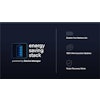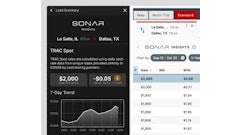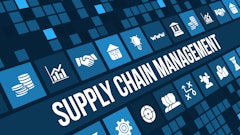
The growing web of global environmental regulations is forcing the entire supply chain to examine its exposure to potential disruptions caused as a result of regulatory mandates like the EU's RoHS and REACH. While the majority of companies are being reactive when it comes to dealing with these mandates, a few leading enterprises have adopted proactive strategies for mitigating the supply discontinuities caused by these regulations. As a result, these leading-edge innovators are realizing a competitive advantage by better positing their supply chains to ensure uninterrupted supplies for themselves and their customers.
Schneider Electric is one such innovator adopting a proactive strategy for managing the supply risks associated with environmental regulations. The company, based in France, is a global leader in energy management systems, with revenues topping 18 billion euros last year. Schneider Electric operates worldwide, and its engineering and supply chain functions operate globally at more than 200 manufacturing sites that produce for the global market.
The strategy that Schneider Electric has adopted to manage REACH is exemplary of the company's proactive approach to dealing with environmental regulations. REACH — the Registration, Evaluation, Authorization and restriction of Chemical substances — already is having a major impact on global supply chains across industry sectors and geographies. It represents extensive reform of how chemical substances are regulated, and its scope and severity will continue to broaden as unsafe, unknown, or harmful chemicals are monitored, evaluated, and potentially restricted from further use.
Schneider Electric is the global specialist in energy management and has made a public commitment to sustainability, helping its customers make the most of their energy in an effort to achieve more while using less of our common planet. At the company, REACH has executive engagement and is linked to its sustainability mission. For Schneider Electric, compliance is not optional, in part because of its EU operations and the sheer size of its global supply chain. However, it is also because of this commitment to corporate social responsibility, according to Alain Digeon, senior vice president, globalization and industry, Environment Projects, at Schneider Electric. But Digeon says that the company is committed to Schneider's downstream supply chain requirements, too, in formulating its REACH strategy. "We want to facilitate the lives of our customers and of their customers, and in that context complying with laws and standards is a major step in that direction," he says.
The Complexity of REACH
Digeon has first-hand experience with the challenges that environmental regulations pose and the steps that companies can take both to ensure compliance and also to mitigate the risks associated with these mandates. He has been with Schneider Electric for almost 15 years, and he presently is in charge of implementing environmental projects with Schneider Electric, in particular the RoHS and REACH regulations. Digeon has spoken before various industry audiences about the challenges of managing REACH, including earlier this year on a Supply & Demand Chain Executive Web conference (Compliance Conundrum: Schneider Electric Talks REACH) produced in partnership with IHS, a leader in enabling sustainability, environmental compliance, and supply chain management.
One of the challenges associated with REACH, Digeon notes, is its sheer scope. "REACH is very complex, some people say the most complex piece of legislation ever in Europe," he says.
As Supply & Demand Chain Executive reported earlier this year in the whitepaper "Supply Chain Readiness for REACH and Global Material Regulations":
This expanding scope of REACH over time, Digeon says, means that the regulation is not static, and compliance is not a one-time event. "It is a 'movie' rather than a 'still picture,'" he says, "that is, it (and its impacts) will evolve over time."
Further, as Supply & Demand Chain Executive reported in the "Supply Chain Readiness" whitepaper:
As a result, Digeon says, REACH will impact not companies but entire supply chains, which must act to put in place a surveillance mechanism to monitor a list of substances, authorizations, restrictions and so on, in order to avoid unexpected disruptions from new or existing curbs. This means that REACH places additional data management responsibilities not only on OEMs but their suppliers, too. "REACH requires a lot data, new data, and changing data. It needs to be exchanged between customers and suppliers, and some of these suppliers have never heard about REACH and could care less about it," Digeon says.
Adding to the complexity, some of the difficulties associated with REACH arise only when a company is faced with specific circumstances. "For example," Digeon says, "what are the conditions under which a recycled substance can be considered equivalent to a non-recycled substance? Or, when you buy the same commercial reference in Europe and in Asia from the same very large supplier, are you sure it is exactly the same material declaration which is applicable? Or, you are impacted by decisions made by some of your existing suppliers to not comply with REACH."
Schneider Electric's REACH Strategy
To tackle REACH, Schneider Electric first set up a specific project under its corporate sustainability program, led by Digeon, to make the company compliant. On a corporate basis, the project includes just one other person beside Digeon, but Digeon works with representatives nominated by all organizations across the company — manufacturing, purchasing, business units, R&D, sales, IT and so on — and a monthly product review is held. Digeon has sponsorship from two executive vice presidents within the company, and he reports regularly to the company's Executive Committee on progress and issues impacting this sustainability program.
The company's first step was to identify its role within its existing supply chain in the REACH context. Schneider Electric did a worldwide inventory — not just in Europe — of what they buy from the chemical industry at large. They looked specifically at questions like, do they themselves import chemical substances into Europe or not, and do their products intentionally release chemical substances or not? These questions are very important as the consequences are huge should the company have to send to the ECHA reports about chemical analysis and chemical safety. REACH is just in its infancy, and yet the European Unions Consumer Affairs is already calling out products sold into the region which pose a chemical risk and, according to the REACH regulation, are prohibited. This is already resulting in enforcement scenarios like voluntary halt to sales or withdrawal from the market. Schneider Electric determined whether, from a REACH perspective, the company was the supplier of an article, that is, whether a given article is being manufactured in Europe or imported by Schneider Electric from non-EU countries. Schneider Electric also makes equipment and systems for specific customers to whom they have also to deliver REACH information since they could sell those items in Europe.
As a consequence, Schneider Electric is adapting its processes across different functions. In purchasing, they are evolving their contractual agreements with customers and suppliers and identifying trustworthy suppliers. In R&D, they are requiring REACH data for any new product design, but also for the existing catalog of products. Their materials experts are working with suppliers to understand the steps the suppliers are taking to secure Schneider Electric's supply while making Schneider Electric's products greener in the future. The company's IT function is adapting Schneider Electric's technology toolsets so that material declaration forms can be attached to different levels within a bill of material.
Schneider Electric also intends to make legally requested information available to customers on the Web, with additional information accessible internally, within the next few months. Sales, marketing and support teams are given an understanding of REACH and the way it is handled within Schneider Electric, and they help sales people answer customer requests, which sometimes may go beyond the legal requirements. Last, but not least, Schneider Electric carefully monitors the environment: What are the company's competitors or other industries doing? Is Schneider Electric doing too much or too little in line with its strategy? Are they efficiently serving their customers? For all these reasons REACH cannot be disconnected from a global view of the supply chain, Digeon says.
Challenges of Compliance
Going a bit deeper, the legal requirements for an article manufacturer are presently to provide, for each of its commercial products, the contents for the 15 substances of very high concern, SVHCs, identified so far. Just assembling the full list of commercial products sold by Schneider Electric is challenging, Digeon notes, since much of the company's growth has come through acquisitions, and not all of the acquired companies have been fully integrated yet. In addition, each affiliate of Schneider Electric may have been extending its product catalog locally for commercial or logistics reasons, again making it difficult to gain a complete and clear view of the company's full catalog of products. Moreover, as noted above, the SVHC list is set to grow and is expected to see addition to the list this year, meaning that product information management must become an ongoing process.
This will impact many product and manufacturing processes, both within Schneider Electric and at the company's suppliers and subcontractors. Schneider Electric has a lengthy qualification process for its product and processes, so the company must be prepared for some material substitutions. "When materials experts say that a given SVHC has made it to the authorization list, but they believe that the complete family of similar chemical substances may well be restricted in the future, Schneider Electric needs to prepare for this, and that takes time and effort," Digeon says.
For example, Digeon cites surface treatments, which could be significantly impacted. Schneider Electric must consider whether it needs to redesign some parts to avoid a specific surface treatment, but also how to avoid changing one part after the other in a complex product, how to mitigate the risk of not being able to buy some parts, how trustworthy the information they have is, and how they can mitigate their legal risk of being not compliant. "All these questions must be answered through the joint efforts of product designers and architects, material experts, purchasing, advanced manufacturing people and even lawyers in order to prioritize the workload," Digeon says.
The Data Conundrum
Digeon emphasizes that data management is essential to implementing REACH because it requires new flows of data to be organized within the company and with outside suppliers and customers, and also because the requirements will evolve overtime. "The list of SVHCs will increase, and new aspects of REACH like certification will impact certain legal entities within a group of companies, so it is necessary to monitor the legal environment, the supply environment and customer requests, and to adapt offer development processes," Digeon explains. "There will be a lot of new requests for product information to handle, and companies must, to the extent possible, take a global view of how their systems will support REACH-related requests."
REACH clearly imposes a burden on companies, requiring notification to customers at near-zero or zero cost. But Digeon also believes that implementing a REACH strategy can reinforce relationships with customers if the company can respond to customer information requests in a timely manner, or if the company can help customers understand aspects of REACH that they may have overlooked. For this reason, Digeon believes that customer notification must be an important goal and priority of a REACH strategy. However, achieving customer notification requires first building infrastructure like databases that customers can access for their queries on the Internet, tools to upload data from suppliers or from a third-party content provider, and solutions to combine the data with product design knowledge in order to generate information for customers. REACH also requires data to be communicated to customers over an extended period — 10 years — creating an additional requirement for the IT infrastructure supporting REACH.
Because Schneider Electric has been working on RoHS for some time, they have set up a Web-based database accessible for customers and other interested parties. This database provides the RoHS status for many of Schneider Electric's SKUs. But the amount of data required for REACH is making this database obsolete. Because Schneider Electric needed to put a solution in place to ensure customer satisfaction around REACH, based on their past experience and on customers' feedback, they opted for a more complete, though still Web-based tool. They chose to implement this database at the corporate level for two reasons: First, the company is deploying a new ERP system worldwide, and this deployment could prove beneficial for the REACH project in terms of providing a global data management infrastructure. Second, the large number of data sources involved in the REACH project means that if the company does not start with a global view, they will pay for it whenever a reorganization takes place or there are changes in the supply chain. Interestingly, Digeon believes that REACH can serve as an excellent "health indicator" of a company's IT systems: if those systems are capable of handling REACH's requirements, then the IT and operations people have been doing their job, he says.
Embracing the Future
Importantly, Schneider Electric's REACH initiative is part of the company's overall strategy around sustainability, which has C-level visibility within the organization. This has a direct impact on the resources that the company is able to bring to bear to address REACH, according to Digeon.
"Obtaining money and expertise from your company can be best achieved if there is a corporate commitment to 'go green,'" Digeon says. "This is what has been done at Schneider Electric, and in this context REACH is perceived as a way of improving our competitive positioning. REACH therefore receives the appropriate support from top management of our company, and this is a key success factor for implementing such a complex project." ¦
Schneider Electric is one such innovator adopting a proactive strategy for managing the supply risks associated with environmental regulations. The company, based in France, is a global leader in energy management systems, with revenues topping 18 billion euros last year. Schneider Electric operates worldwide, and its engineering and supply chain functions operate globally at more than 200 manufacturing sites that produce for the global market.
The strategy that Schneider Electric has adopted to manage REACH is exemplary of the company's proactive approach to dealing with environmental regulations. REACH — the Registration, Evaluation, Authorization and restriction of Chemical substances — already is having a major impact on global supply chains across industry sectors and geographies. It represents extensive reform of how chemical substances are regulated, and its scope and severity will continue to broaden as unsafe, unknown, or harmful chemicals are monitored, evaluated, and potentially restricted from further use.
Schneider Electric is the global specialist in energy management and has made a public commitment to sustainability, helping its customers make the most of their energy in an effort to achieve more while using less of our common planet. At the company, REACH has executive engagement and is linked to its sustainability mission. For Schneider Electric, compliance is not optional, in part because of its EU operations and the sheer size of its global supply chain. However, it is also because of this commitment to corporate social responsibility, according to Alain Digeon, senior vice president, globalization and industry, Environment Projects, at Schneider Electric. But Digeon says that the company is committed to Schneider's downstream supply chain requirements, too, in formulating its REACH strategy. "We want to facilitate the lives of our customers and of their customers, and in that context complying with laws and standards is a major step in that direction," he says.
The Complexity of REACH
Digeon has first-hand experience with the challenges that environmental regulations pose and the steps that companies can take both to ensure compliance and also to mitigate the risks associated with these mandates. He has been with Schneider Electric for almost 15 years, and he presently is in charge of implementing environmental projects with Schneider Electric, in particular the RoHS and REACH regulations. Digeon has spoken before various industry audiences about the challenges of managing REACH, including earlier this year on a Supply & Demand Chain Executive Web conference (Compliance Conundrum: Schneider Electric Talks REACH) produced in partnership with IHS, a leader in enabling sustainability, environmental compliance, and supply chain management.
One of the challenges associated with REACH, Digeon notes, is its sheer scope. "REACH is very complex, some people say the most complex piece of legislation ever in Europe," he says.
As Supply & Demand Chain Executive reported earlier this year in the whitepaper "Supply Chain Readiness for REACH and Global Material Regulations":
The REACH legislation took effect on June 1, 2007. The regulation provides for phased requirements over an 11-year period, including obligations to register, with the European Chemicals Agency (ECHA) in Helsinki, substances imported into, or used within, the European Union. Nearly 150,000 substances were pre-registered with ECHA by 65,000 companies by a December 1, 2008, deadline. In addition, an expanding list of "Substances of Very High Concern" (SVHCs) will be subject to potential substitution in products. Companies also must be prepared to proactively notify downstream users regarding the presence of SVHCs in their product and respond to consumer requests for information on SVHC presence within 45 days.
This expanding scope of REACH over time, Digeon says, means that the regulation is not static, and compliance is not a one-time event. "It is a 'movie' rather than a 'still picture,'" he says, "that is, it (and its impacts) will evolve over time."
Further, as Supply & Demand Chain Executive reported in the "Supply Chain Readiness" whitepaper:
The impact of REACH will extend beyond companies engaged directly in business within the EU. It will apply to companies with relatively low levels of EU revenue — and even companies that do no business in the EU but that engage with suppliers or customers that are involved in the European market. A customer that sells into the EU may require information on SVHC content to satisfy its own regulatory obligations, while suppliers that service customers in the EU may opt to discontinue production of parts or component that include SVHCs rather than continuing to provide both "compliant" and "non-compliant" product lines.
As a result, Digeon says, REACH will impact not companies but entire supply chains, which must act to put in place a surveillance mechanism to monitor a list of substances, authorizations, restrictions and so on, in order to avoid unexpected disruptions from new or existing curbs. This means that REACH places additional data management responsibilities not only on OEMs but their suppliers, too. "REACH requires a lot data, new data, and changing data. It needs to be exchanged between customers and suppliers, and some of these suppliers have never heard about REACH and could care less about it," Digeon says.
Adding to the complexity, some of the difficulties associated with REACH arise only when a company is faced with specific circumstances. "For example," Digeon says, "what are the conditions under which a recycled substance can be considered equivalent to a non-recycled substance? Or, when you buy the same commercial reference in Europe and in Asia from the same very large supplier, are you sure it is exactly the same material declaration which is applicable? Or, you are impacted by decisions made by some of your existing suppliers to not comply with REACH."
Schneider Electric's REACH Strategy
To tackle REACH, Schneider Electric first set up a specific project under its corporate sustainability program, led by Digeon, to make the company compliant. On a corporate basis, the project includes just one other person beside Digeon, but Digeon works with representatives nominated by all organizations across the company — manufacturing, purchasing, business units, R&D, sales, IT and so on — and a monthly product review is held. Digeon has sponsorship from two executive vice presidents within the company, and he reports regularly to the company's Executive Committee on progress and issues impacting this sustainability program.
The company's first step was to identify its role within its existing supply chain in the REACH context. Schneider Electric did a worldwide inventory — not just in Europe — of what they buy from the chemical industry at large. They looked specifically at questions like, do they themselves import chemical substances into Europe or not, and do their products intentionally release chemical substances or not? These questions are very important as the consequences are huge should the company have to send to the ECHA reports about chemical analysis and chemical safety. REACH is just in its infancy, and yet the European Unions Consumer Affairs is already calling out products sold into the region which pose a chemical risk and, according to the REACH regulation, are prohibited. This is already resulting in enforcement scenarios like voluntary halt to sales or withdrawal from the market. Schneider Electric determined whether, from a REACH perspective, the company was the supplier of an article, that is, whether a given article is being manufactured in Europe or imported by Schneider Electric from non-EU countries. Schneider Electric also makes equipment and systems for specific customers to whom they have also to deliver REACH information since they could sell those items in Europe.
As a consequence, Schneider Electric is adapting its processes across different functions. In purchasing, they are evolving their contractual agreements with customers and suppliers and identifying trustworthy suppliers. In R&D, they are requiring REACH data for any new product design, but also for the existing catalog of products. Their materials experts are working with suppliers to understand the steps the suppliers are taking to secure Schneider Electric's supply while making Schneider Electric's products greener in the future. The company's IT function is adapting Schneider Electric's technology toolsets so that material declaration forms can be attached to different levels within a bill of material.
Schneider Electric also intends to make legally requested information available to customers on the Web, with additional information accessible internally, within the next few months. Sales, marketing and support teams are given an understanding of REACH and the way it is handled within Schneider Electric, and they help sales people answer customer requests, which sometimes may go beyond the legal requirements. Last, but not least, Schneider Electric carefully monitors the environment: What are the company's competitors or other industries doing? Is Schneider Electric doing too much or too little in line with its strategy? Are they efficiently serving their customers? For all these reasons REACH cannot be disconnected from a global view of the supply chain, Digeon says.
Challenges of Compliance
Going a bit deeper, the legal requirements for an article manufacturer are presently to provide, for each of its commercial products, the contents for the 15 substances of very high concern, SVHCs, identified so far. Just assembling the full list of commercial products sold by Schneider Electric is challenging, Digeon notes, since much of the company's growth has come through acquisitions, and not all of the acquired companies have been fully integrated yet. In addition, each affiliate of Schneider Electric may have been extending its product catalog locally for commercial or logistics reasons, again making it difficult to gain a complete and clear view of the company's full catalog of products. Moreover, as noted above, the SVHC list is set to grow and is expected to see addition to the list this year, meaning that product information management must become an ongoing process.
This will impact many product and manufacturing processes, both within Schneider Electric and at the company's suppliers and subcontractors. Schneider Electric has a lengthy qualification process for its product and processes, so the company must be prepared for some material substitutions. "When materials experts say that a given SVHC has made it to the authorization list, but they believe that the complete family of similar chemical substances may well be restricted in the future, Schneider Electric needs to prepare for this, and that takes time and effort," Digeon says.
For example, Digeon cites surface treatments, which could be significantly impacted. Schneider Electric must consider whether it needs to redesign some parts to avoid a specific surface treatment, but also how to avoid changing one part after the other in a complex product, how to mitigate the risk of not being able to buy some parts, how trustworthy the information they have is, and how they can mitigate their legal risk of being not compliant. "All these questions must be answered through the joint efforts of product designers and architects, material experts, purchasing, advanced manufacturing people and even lawyers in order to prioritize the workload," Digeon says.
The Data Conundrum
Digeon emphasizes that data management is essential to implementing REACH because it requires new flows of data to be organized within the company and with outside suppliers and customers, and also because the requirements will evolve overtime. "The list of SVHCs will increase, and new aspects of REACH like certification will impact certain legal entities within a group of companies, so it is necessary to monitor the legal environment, the supply environment and customer requests, and to adapt offer development processes," Digeon explains. "There will be a lot of new requests for product information to handle, and companies must, to the extent possible, take a global view of how their systems will support REACH-related requests."
REACH clearly imposes a burden on companies, requiring notification to customers at near-zero or zero cost. But Digeon also believes that implementing a REACH strategy can reinforce relationships with customers if the company can respond to customer information requests in a timely manner, or if the company can help customers understand aspects of REACH that they may have overlooked. For this reason, Digeon believes that customer notification must be an important goal and priority of a REACH strategy. However, achieving customer notification requires first building infrastructure like databases that customers can access for their queries on the Internet, tools to upload data from suppliers or from a third-party content provider, and solutions to combine the data with product design knowledge in order to generate information for customers. REACH also requires data to be communicated to customers over an extended period — 10 years — creating an additional requirement for the IT infrastructure supporting REACH.
Because Schneider Electric has been working on RoHS for some time, they have set up a Web-based database accessible for customers and other interested parties. This database provides the RoHS status for many of Schneider Electric's SKUs. But the amount of data required for REACH is making this database obsolete. Because Schneider Electric needed to put a solution in place to ensure customer satisfaction around REACH, based on their past experience and on customers' feedback, they opted for a more complete, though still Web-based tool. They chose to implement this database at the corporate level for two reasons: First, the company is deploying a new ERP system worldwide, and this deployment could prove beneficial for the REACH project in terms of providing a global data management infrastructure. Second, the large number of data sources involved in the REACH project means that if the company does not start with a global view, they will pay for it whenever a reorganization takes place or there are changes in the supply chain. Interestingly, Digeon believes that REACH can serve as an excellent "health indicator" of a company's IT systems: if those systems are capable of handling REACH's requirements, then the IT and operations people have been doing their job, he says.
Embracing the Future
Importantly, Schneider Electric's REACH initiative is part of the company's overall strategy around sustainability, which has C-level visibility within the organization. This has a direct impact on the resources that the company is able to bring to bear to address REACH, according to Digeon.
"Obtaining money and expertise from your company can be best achieved if there is a corporate commitment to 'go green,'" Digeon says. "This is what has been done at Schneider Electric, and in this context REACH is perceived as a way of improving our competitive positioning. REACH therefore receives the appropriate support from top management of our company, and this is a key success factor for implementing such a complex project." ¦













![Pros To Know 2026 [color]](https://img.sdcexec.com/mindful/acbm/workspaces/default/uploads/2025/08/prostoknow-2026-color.mduFvhpgMk.png?ar=16%3A9&auto=format%2Ccompress&bg=fff&fill-color=fff&fit=fill&h=135&q=70&w=240)